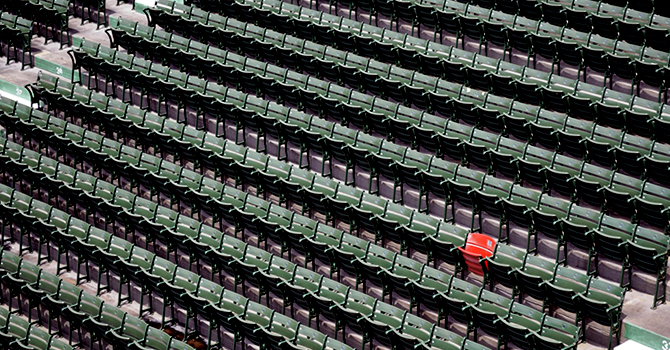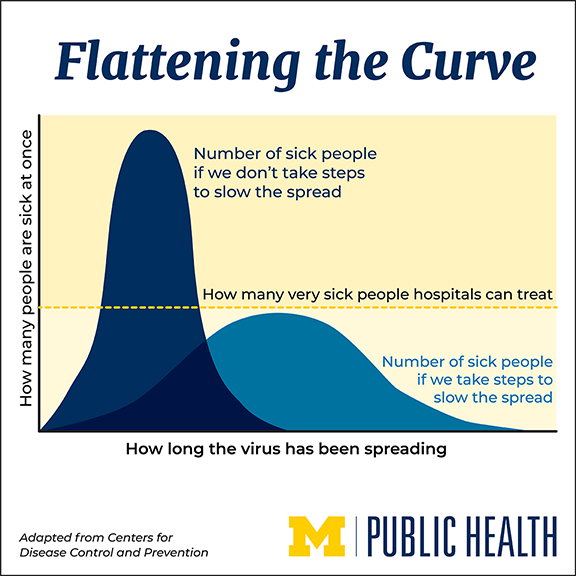Mass Cancellations, Slowing the Spread, and Flattening the Curve

Q&A with Laura Power
Clinical Assistant Professor of Epidemiology and Internal Medicine, Director of the Preventive Medicine Residency
Click Here for the Latest on COVID-19 from Michigan Public Health ExpertsUniversities and schools are moving classes online. Sports leagues and arts organizations have cancelled entire seasons, and thousands of other events across the country have been and still are being cancelled or postponed. Many municipalities and even states have restricted or closed restaurants, casinos, and other venues where people would interact.
To better understand the reason for all of these cancellations and what it means to “flatten the curve,” we asked Dr. Laura Power, clinical assistant professor of Epidemiology and Internal Medicine and director of the Preventive Medicine Residency at the University of Michigan School of Public Health, for some perspectives from the field of public health.

Why are these mass cancellations so important to slowing the spread of the coronavirus?
There are natural frustrations and disappointments that come with these cancellations. Event organizers, speakers, performers, and sports fans all put time, money, and many other resources into each of these events. From a public health perspective, each of these events is what infectious disease experts call a “congregant event,” a space and time where a group of people comes together to interact socially. During these interactions, we might touch surfaces, touch other people’s hands, sneeze or cough germs into the air, eat food that’s been touched or coughed on, and so on.
Each of these seemingly minor interactions is an opportunity for the virus to spread. And we are trying to slow that spread, to flatten the curve of this virus’s impact on the entire population so that the increase in coronavirus cases are spread out over as much time as possible.
What does it mean to “flatten the curve” of this disease’s spread? Aren’t we all going to get sick anyway?
Eventually, nearly all of us are likely to be exposed to this strain of the coronavirus, and many of us who are infected will have some kind of symptoms. Some of us will have severe cases. This is a respiratory disease that has shown itself to have an especially severe impact on the elderly and those with compromised immune systems. We have not seen this strain of coronavirus before, so we’re still learning about it.
It literally saves lives when we all are mindful of the guidelines coming from public health, medical, and other governmental authorities for social distancing.
For the people who do have severe cases and need medical treatment, we need our health care systems to be ready to take care of them. If we all get sick in a short period of time—as happened in China, Italy, and now Spain—then health care clinics will be heavily burdened with severe cases. In such cases, health care workers might not be able to keep up, supplies like masks, testing kits, and ventilators often run low or run out, and many of the people who need critical care will not get the best care they need or, in extreme circumstances, any care.
So it literally saves lives when we all are mindful of the guidelines coming from public health, medical, and other governmental authorities for social distancing, including all of these event cancellations. The disease will spread no matter what, so these precautions help reduce human interactions and spread out the number of infections over months rather than weeks. The rising curve of the disease’s spread can flatten out so that we have a more steady flow of cases—that’s what is meant by “flattening the curve.”
To support that effort, we can all follow the recommendations for social distancing and do our best to support others in following them. Flattening that curve out over months rather than weeks also gains us more time potentially to develop a vaccine that would protect us against this new strain of coronavirus.
How else can we help slow the spread and flatten the curve?
First, follow all the guidelines about social distancing, including not attending or planning events. Be extremely vigilant in your personal hygiene when you do have to go out, say for groceries or medication. Keep six feet or more from others, use hand sanitizer, wash your hands regularly, and if you are sick—with the coronavirus disease or with any other cold, flu, or other infectious disease you might spread—do your best not to go out at all. Our health care workers are also seeing patients for colds, seasonal flu, and the many other diseases that bring people into a health care clinic.
The more people who follow the recommendations, the more we win the numbers game against the virus’s spread.
What we’re trying to accomplish here—together—is similar to the logic of vaccine coverage during flu season and with other diseases where we have a vaccine. The more people who follow the recommendations, the more we win the numbers game against the virus’s spread. Even if you see others not complying with recommendations, if you do comply, it will help the community around you have fewer cases and stay healthier. It will help health care workers not get overwhelmed.
In all of this, remember, too, that the people making decisions to cancel events—from local organizers and authorities all the way to the federal government—are doing their best with the information we have today. The situation changes every day, so we should be paying attention and trying to understand and do what we can to support health across the population at this critical time.
